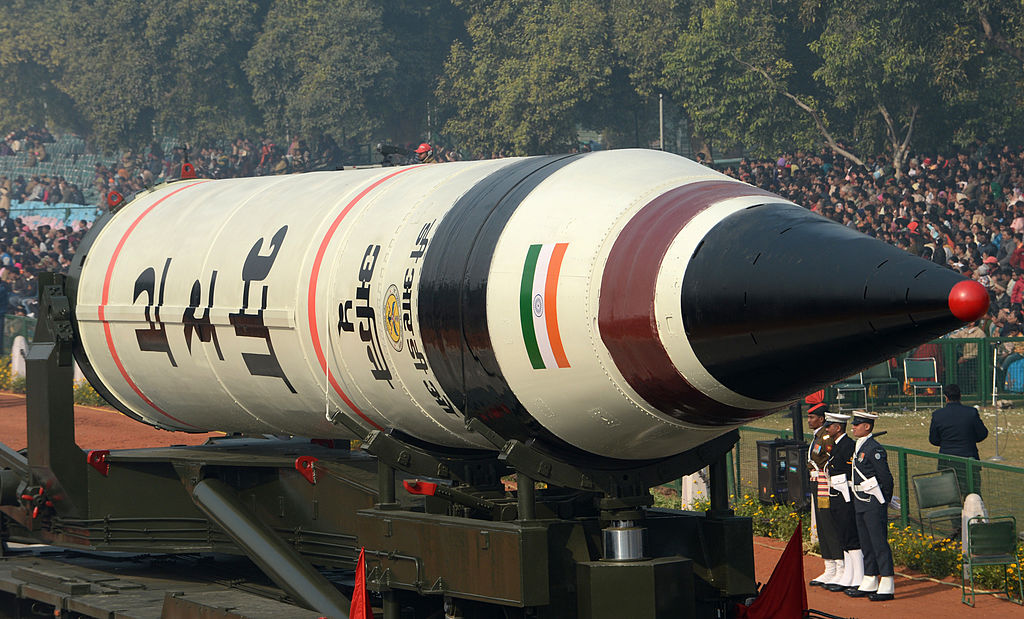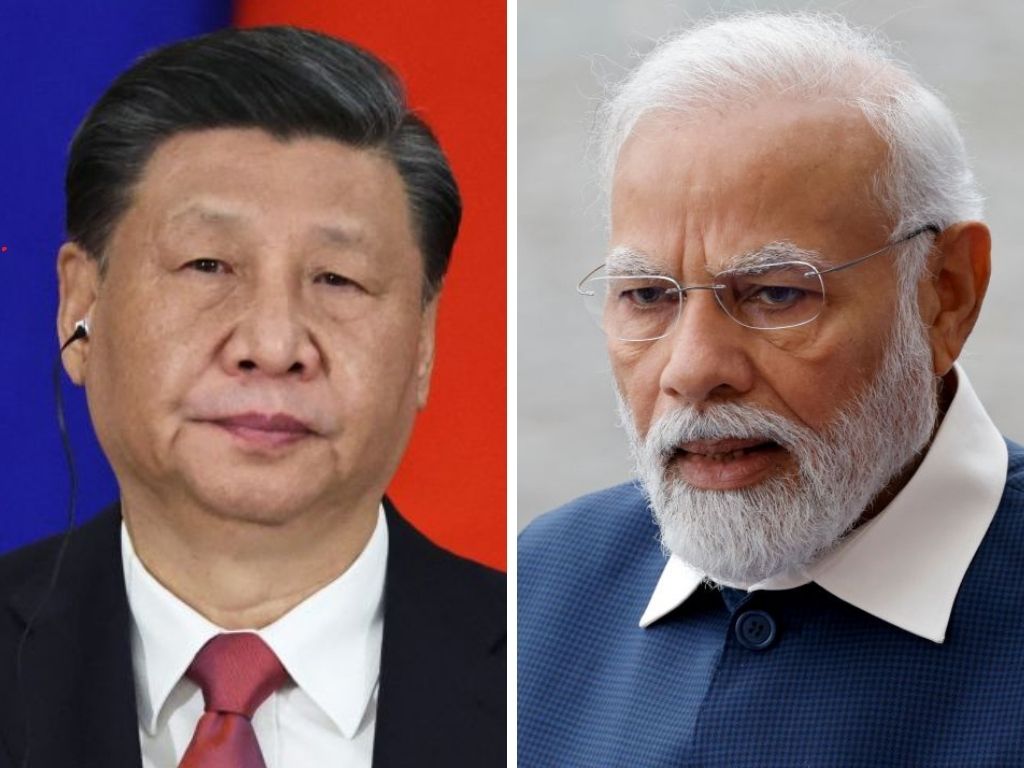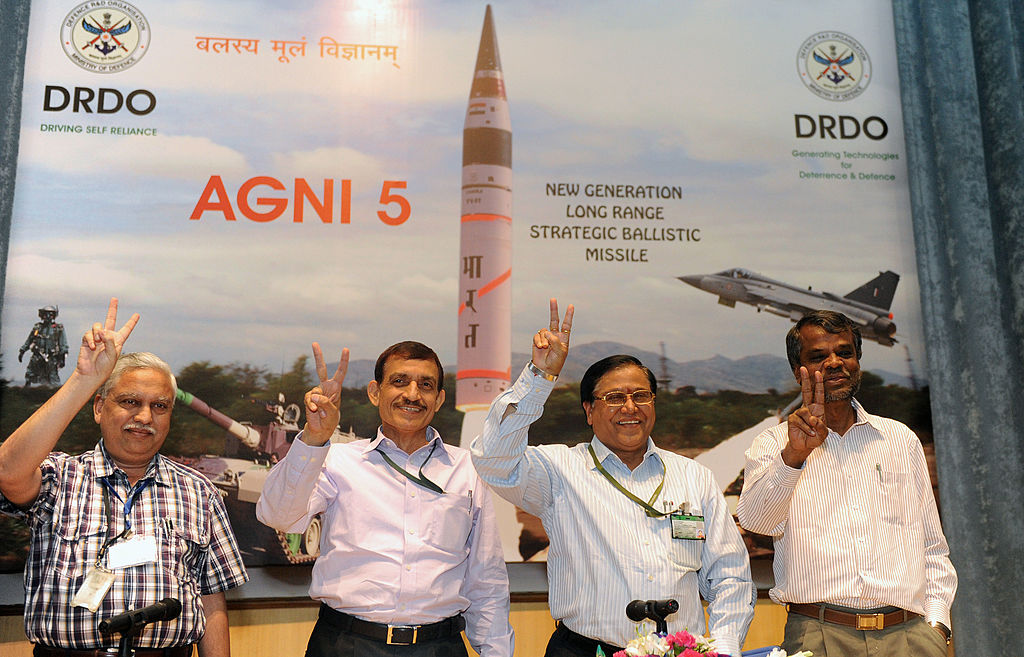- Saturday, July 27, 2024
The testing of the MIRV-equipped missile that can carry a number of warheads and hit multiple targets is being seen as a game-changer in South Asian arms race but not all experts are in agreement.

By: indiaweekly.biz Staff
ON March 11, India successfully conducted the first test flight of the Agni-5 missile off the coast in its eastern state of Odisha as part of ‘Mission Divyastra’, which is considered a key milestone in its nuclear capability. Developed by India’s Defence Research & Development Organisation (DRDO), the missile, which takes its name from the Sanskrit name for “fire”, marks a significant uptick in India’s military might since it is capable of carrying a number of warheads and hitting many targets. The warheads could also feature decoys to fox enemy’s ballistic missile programmes.
The special capacity of Agni-5 is enhanced by the MIRV (Multiple Independently Targetable Reentry Vehicle) technology that enables loading of multiple warheads on a single missile delivery system and programming the to strike different targets.
Agni missiles have been a key asset of India’s armed forces for decades and the addition of the latest equipped with the MIRV technology makes the arsenal more lethal, particularly in a neighbourhood which is far from peaceful.
The Agni-5 missile, which has been successfully tested several times since 2012, also has a range of more than 5,000 kilometres, making it a long-range one and giving India the capacity to reach most parts of China, a country which is almost three times its size.
Read: India conducts first flight test of Agni-5, a missile that can hit multiple targets

India, in fact, has for the first time acknowledged to have successfully developed the MIRV technology that was developed in the 1960s, and is in possession of only a few countries today.
India Weekly spoke to experts to understand the difference Agni-5 missile could make when it comes to the power game in the Asian theatre, particularly between countries such as India, China and Pakistan, which has also been trying to master the MIRV technology.
Retired commodore R Seshadri Vasan, director general of Chennai Centre for China Studies in Chennai in the southern Indian state of Tamil Nadu, told India Weekly while highlighting one of the special features of the MIRV technology that it further augments India’s No First Use response structures, meaning strengthening its second-strike capability from sea, air and land forces from several platforms and dispersed locations.
Strategic security and intelligence analyst Col Ramani Hariharan was of the opinion that the Agni-5 missile’s MIRV feature makes it a game-changer in the Indo-Pacific strategic context.
“While the missile’s 5,000-km range makes it an Intermediate Range Ballistic Missile (IRBM), some reports suggest that it can be increased to 8,000 kms which makes it an Intercontinental Ballistic Missile (ICBM). Along with it, the MIRV feature which is said to engage six targets in a single launch and the use of decoys makes Agni-5 a key contributor to India’s enhanced strategic nuclear capability,” he said.
Dinshaw Mistry, a professor of International Affairs and Asian Studies at the University of Cincinnati, USA, and an authority on security studies and Asian security, also agreed that the missile’s range gives India a strategic advantage vis-à-vis China.
“One key feature of the missile is its range of approximately 5,000 kilometers, which can increase with lighter payloads. This range enables India to strike all major cities in China from launch sites that are far from the border regions and therefore somewhat more secure from strikes by China and Pakistan,” he told the publication, adding, “Another feature is its multiple warheads, which enables India to use fewer missiles to deliver more warheads to more targets.”
However, Mistry was not convinced that the MIRV technology, which is more useful for nuclear first strike policy, would alone alter India’s nuclear doctrine that doesn’t believe in first strike. Stressing that the technology is as useful for retaliatory second strikes, Mistry said, “MIRV technology alone is not the decisive factor in decisions to change doctrines. Other security and technological considerations related to enhancing the credibility and implementation of deterrence are also significant.”

That Agni-5 can cover a bigger distance could have a major international ramification, not just by means of enhancing India’s nuclear capability but by revolutionizing the pattern of nuclear capability for developing nations. It is often financially challenging for such nations to acquire ICBMs which are very expensive and they have a more viable option in developing long-range missiles with multiple warheads.
India has already exhibited before the world its capacity to conduct distant space missions on a moderate budget. Just replicating the same in the realm of nuclear capability would add more to its claim to potential leadership in the Global South.
Coming back to India’s Agni-5 test flight, it also puts the focus on the pillars of its nuclear doctrine and how the missile makes it more robust. According to Col Hariharan, the weapon adds strength to India’s NFU policy since by possessing a deadly missile such as Agni-5, it forces its foes who do not subscribe to NFU to keep in mind the potentially disastrous consequences of making use of the nuclear weapons first.
Similarly, Agni-5 also makes the second pillar of India’s nuclear doctrine – minimum credible deterrence (CMD) – strong. It implies maintaining sufficient nuclear arsenal to deter potential adversaries while avoiding an arms buildup. By developing something like Agni-5, India also makes its nuclear arsenal potent enough to create a deterrence.
But to what extent can Agni-5 succeed in deterring nuclear adversaries such as China and Pakistan?
There were reports that Beijing dispatched a research vessel near the Indian coasts to keep a watch on the test flight while Pakistan accused India of not following the three-day timeline stipulated in Article 2 of the Agreement on Pre-notification of Flight Testing of Ballistic Missiles signed between the two countries in 2005.
According to Commodore Vasan, “China has no choice but to acknowledge India’s growing prowess in multiple military domains. By increasing engagement with like-minded nations, India has managed to apply pressure on China. Beijing will rework its options based on evaluation of India’s constant enhancements in its military arsenal and preparedness.”
Mistry, however, believes that Agni-5 will rather have a symbolic impact on the regional arms race with China.
“Agni-5 will have a symbolic impact of helping India close the gap with China in terms of their nuclear forces. But even with the Agni-5, India is far from matching China since China has a much greater number and wider set of platforms for nuclear delivery than India,” he said.
John Erath, senior policy director at the Center for Arms Control and Non-Proliferation, Washington DC, USA, believes that diplomacy is still the best option available.
He told India Weekly that Beijing pretends not to be worried about the Indian deterrence, preferring to “justify” its unconstrained nuclear buildup by citing greater US (and Russian) numbers.
“It is significant, however, that the great majority of Chinese missiles cannot reach U.S. territory but can strike most of India. An India-China arms race is in no one’s interest, especially since both parties already have the capability to deter each other. In the end, deploying new and improved weapons systems is no substitute for diplomacy and conflict prevention,” he said.
On the question of India’s NFU policy and how it aligns with the MIRV technology, Erath said an NFU stance is only effective insofar as it is credible and building nuclear warfighting capabilities could well undermine that credibility.
Col Hariharan gives a more detailed observation on how India’s testing of Agni-5 could challenge China. He said the development will send a strong signal to China at various levels such as strategic and regional..
“Strategically, it signals India’s determination to strengthen its strategic capabilities and resolve to protect its national interests. The MIRV missile enhances India’s nuclear deterrence by gaining the ability to deliver multiple warheads, discouraging any aggressive action.
“The missile’s canister-launch system enables quick transportation, less maintenance and immediate response, strengthening its second-strike capability. Thus, Agni-5 MIRV provides India the ability to counterbalance China’s capability using missiles like Dong Feng -41. It was not surprising to see a Chinese spy ship, less than 480 km from the test site off the coast of Visakhapatnam,” he told India Weekly.
He also cautioned that Beijing would now make efforts to enlarge its foothold in some of India’s smaller neighbours in South Asia, such as the Maldives, with which New Delhi is currently having a tense relation, and Sri Lanka. According to the security expert, China could do this to improve its cyberwarfare capability and eavesdrop on India’s military moves.
“We can also expect China to help Pakistan develop further its MIRV capability using India-specific Ababeel medium range ballistic missile, last tested on October 18, 2023,” he added.
Erath, however, feels that India already has missiles that can strike potential adversaries adequately for deterrence, and therefore the increased capabilities are “somewhat redundant”. He warned that such capabilities would be significant only in a nuclear warfighting scenario, and a nuclear war is one everyone loses.
There is little doubt that India is thinking bigger with the Agni-5 missile. But could an ambition of deterring the potential adversaries with an MIRV-equipped weapon system also reduce the credibility of its NFU policy?
It would also be interesting to see the next move that China contemplates after India’s testing of its high-profile missile. The testing has come at a time when China is trying to increase its presence among India’s smaller neighbours and trigger a competition to broaden strategic influence, which gives a signal that the two nuclear-armed neighbours are in no mood to relax.
However, a silver lining can be seen in various ways through which India can benefit from leveraging such an existing technology and the cost-effective way of its implementation. Leaving out the more sinister ideas of arms race and potential destruction, the purely technological advancement that allows India to upgrade its missile system can be handy in pursuing welfare goals.